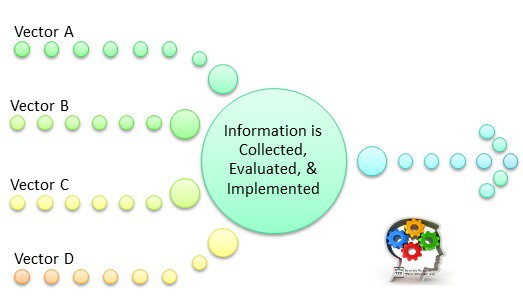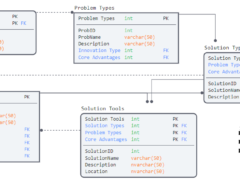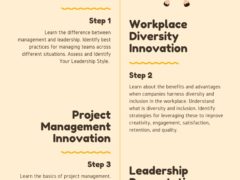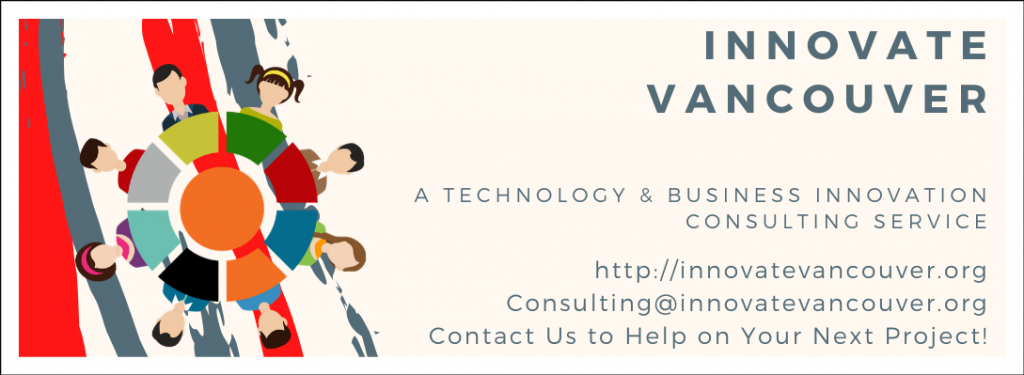Information vectors fuel innovation. The challenge is that information gathered from one vector may be completely ignored from another. This differential perspective is influenced by the place, resources, and reference point of the observer. The observing vector thus determines what is valued. For most companies, and teams, the options are separate and distinct. Observing one information vector usually precludes engaging others.
 Identifying innovations that are both marketable and value adding remains the challenge of each and every entrepreneur. Because information vectors influence and determine the path of inquiry understanding them becomes crucial towards identifying opportunities for innovation.
Identifying innovations that are both marketable and value adding remains the challenge of each and every entrepreneur. Because information vectors influence and determine the path of inquiry understanding them becomes crucial towards identifying opportunities for innovation.
Without information strategic pursuits, efforts, and coalitions are likely to stumble in the dark from one non-essential product to the next irrelevant service. Information vectors fuel the process of innovation as the curiosity becomes inquiry, and inquiry becomes understanding. The goal is learning to scan the environment to access the often distinct, and contradictory, information and opportunities available.
The path between curiosity and understanding is paved with good intentions and cognitive filters that limit one’s ability to learn. Information that is filtered prior to the analysis and digestion stages may be missing the valuable insights and lessons needed to fuel the teams’ next innovation. The challenge facing leadership is to engage available information vectors without bias, assumption, or other cognitive filters that prematurely alter the information received. There is a significant difference between analyzing information vectors and filtering them. The former supports learning whereas the latter supports the status-quo.
Lebowitz (2015) identifies 20 cognitive biases that effectively limit the learning, discovery, and innovation building process. These biases begin filtering information at step-one of the model above, at the collection stage. The impact this can have on the following stages cannot be understated. If the information available at step four has been altered to fit pre-existing cognitive biases the opportunity for leadership and technological innovation is significantly limited.
process. These biases begin filtering information at step-one of the model above, at the collection stage. The impact this can have on the following stages cannot be understated. If the information available at step four has been altered to fit pre-existing cognitive biases the opportunity for leadership and technological innovation is significantly limited.
The following (short list) of cognitive biases is pulled from Lebowitz’ article in the Business Insider. The type and description of each bias is provided, followed by examples of how these biases can impact the teams’ effort to support leadership and technological innovations.
- Anchoring Bias: People are over-reliant on the first piece of information they hear.
The destructive force of this bias can be felt when gossiping, politics, and ‘limited fields of vision’ are introduced.
Innovation Example from ‘Real Life’: Product was developed based on 2-year-old requirements that were outdated.
- Availability Heuristic: People overestimate the importance of information that is available to them.
The destructive force of this bias can be felt when analysis and decisions are based exclusively on formal reports, meetings, and chain of command.
Innovation Example from ‘Real Life’: Project performance was evaluated based on cultural narrative norms of ‘optimism’ and ‘positivity’ instead of requirements, schedule, quality, and scope.
- Bandwagon Effect: The chance of one person adopting a belief increased based on the number of people who hold that belief.
The destructive force of this bias can be felt when group think and group dynamics influence what information is heard, reviewed, and implemented.
Innovation Example from ‘Real Life’: Team engagement and follow through was based on existing laissez faire norms, exposing the facility to ongoing risks.
- Blind-Spot Bias: Failing to recognize your own cognitive biases is a bias in itself.
The destructive force of this bias can be felt when alternative viewpoints, competing data, and out of the box thinking is ignored.
Innovation Example from ‘Real Life’: New team member expecting project’s to proceed according to the requirements, instead of the unspoken cultural rules which often influence project performance ‘behind the scenes’.
- Choice-Supportive Bias: When you choose something you tend to feel positive about it, even if that choice has flaws.
The destructive force of this bias can be felt when project risks are ignored and the ‘bad idea’ is implemented ‘as planned.’
Innovation Example from ‘Real Life’: A new service line was pitched to the Ministry, with apparent success. Subsequent implementations found the Ministry’s support lacking, with critical items in the supply chain becoming misaligned with the direction of the new service line. Thousands in Ministry funds are allocated, but go unspent.
- Clustering Illusion: This is the tendency to see patterns in random events.
The destructive force of this bias can be felt when ‘conspiracy’ is found at every turn, and when system dynamics are inadequately understood.
Innovation Example from ‘Real Life’: The COTS implementation team insisting on adhering to a specific application architecture and schedule. The software was subsequently not launched as scheduled, and several changes had to be introduced.
- Confirmation bias: We tend to listen only to information that confirms our preconceptions.
The destructive force of this bias can be felt when one’s team, or in-group, is the only source of information.
Innovation Example from ‘Real Life’: Legacy team members voice support for the ongoing progress of the project. Subsequent phase gates are introduced as the project’s scope, schedule, and communication deteriorates. Phase review gates are more ‘form’ than ‘function.’
- Conservatism Bias: Where people favor prior evidence over new evidence or information that has emerged.
The destructive force of this bias can be felt when decisions are rigidly held despite competing information surfacing later on.
Innovation Example from ‘Real Life’: Corporate commitment to traditional project approaches, and outcomes, despite evidence that the environment, and corporate culture, is better matched to pursue other opportunities.
- Information Bias: The tendency to seek information when it does not affect action.
The destructive force of this bias can be felt when the ‘form’ of active discussion exists but without the intended ‘function’, i.e. to evaluate current progress.
Innovation Example from ‘Real Life’: Specific routes of corporate information are emphasized, precluding the exploration of other routes. Only part of the whole is understood as a result.
- Ostrich Effect: The decision to ignore dangerous or negative information by ‘burring’ one’s head in the sand.
The destructive force of this bias can be felt when information leads ‘lock themselves in their office’ and no further discussion or decisions can occur.
Innovation Example from ‘Real Life’: This bias is particularly event when data is evaluated based on its source within the corporate hierarchy, often limiting the exploration of other routes.
- Outcome Bias: Judging a decision based on the outcome and not how the decision is made in the moment.
The destructive force of this bias can be felt when team members continue to ‘proceed on course’ in the pursuit of desired outcomes despite evidence of deteriorating project performance.
Innovation Example from ‘Real Life’: The boss pushes the team to ‘do whatever it takes’ to deliver on contract outcome requirements. Scapegoating and blame surface after the collateral consequences of this approach is realized.
- Overconfidence: Some of us are too confident about our abilities, and this causes us to take greater risks in our daily lives.
The destructive force of this bias can be felt when ‘empire building’ is prioritized over identifying how to best serve the customers.
Innovation Example from ‘Real Life’: Adding service lines, updating program/project names (or management titles), and pursuing new funding sources instead of addressing falling KPI’s in existing operations.
- Placebo Effect: When simply believing that something will have a certain effect on you causes it to have that effect.
The destructive force of this bias can be felt when positive team building experiences reinforces the tendency to approve decisions without an adequate review process.
Innovation Example from ‘Real Life’: The leadership team leaves the cross region collaboration symposium with a renewed commitment to the current vision, strategy, and processes. Key stakeholders feel devalued and unengaged as they are ignored and initiatives move forward.
- Pro-Innovation Bias: When a proponent of an innovation tends to overvalue its usefulness and undervalue its limitations.
The destructive force of this bias can be felt when every incremental change is championed as an essential, and irrevocable, improvement.
Innovation Example from ‘Real Life’: Corporate mergers proceed without adequately performing the initial risk analysis and cultural fit assessment.
- Recency: The tendency to weigh latest information more heavily than older data.
The destructive force of this bias can be felt when teams become too busy to continue the discussion, and instead refer to the most recent decision for implementation.
Innovation Example from ‘Real Life’: Technology project requirements and specifications are updated based on team skills, competencies, and preferences, but without adequate customer consultation or change management/request mechanisms. The product subsequently delivered to the project owner fails to meet original specifications.
- Salience: Our tendency to focus the most easily recognizable features of a person or concept.
The destructive force of this bias can be felt when decisions are made based on convenience and accessibility instead of problem-solution fit.
Innovation Example from ‘Real Life’: Service lines, planning, and strategy emphasize ‘low hanging fruit’ (easily accessible goals) that fails to understand the customer’s needs. Corporate impact KPI’s, aligned with the corporate mission and initial intent, are often unmet as a result.
- Selective Perception: Allowing our expectations to influence how we perceive the world.
The destructive force of this bias can be felt when all projects are evaluated as successful despite failing to meet originally agreed upon requirements.
Innovation Example from ‘Real Life’: Corporate culture, relationships, and dynamics influencing how (or if) performance, output, and feedback is evaluated (or used).
- Stereotyping: Expecting a group or person to have certain qualities without having real information about the person.
The destructive force of this bias can be felt when ideas and information presented by new-comers, or unpopular team members, is automatically evaluated negatively.
Innovation Example from ‘Real Life’: Terminating employees for ‘fit’ instead of leveraging the opportunities for improved quality, effectiveness, and sustainability available through their contributions, perspectives, and skills.
- Survivorship Bias: An error that comes from focusing only on surviving examples, causing us to mis-judge a situation.
The destructive force of this bias can be felt when the status-quo is reinforced, and thinking ‘outside the box’ is treated as ‘taboo’.
Innovation Example from ‘Real Life’: Toxic corporate cultures are often reinforced over time as specific negative experiences continue unabated and ‘survival of the fittest’ strategies are needed just to keep one’s job.
- Zero-Risk Bias: Sociologists have found that we love certainty even when it’s counterproductive.
 The destructive force of this bias can be felt in risk averse environments. This bias not only avoids opportunities but is also prone to follow instead of lead innovation efforts.
The destructive force of this bias can be felt in risk averse environments. This bias not only avoids opportunities but is also prone to follow instead of lead innovation efforts.
Innovation Example from ‘Real Life’: Resistance to adopt new technology even if it would increase productivity, focus impact, and strengthen planning and evaluation.
The impact of these cognitive biases on the company’s ability to leverage information vectors to support leadership innovation cannot be understated. Beginning the process to ‘pull back the veil’ of ignorance begins with continuously asking the following questions:
- Is this information consistent with existing expectations? Why?
- Is this information inconsistent with existing expectations? Why?
- Is any information missing? Why?
How company’s leverage, respond, and apply information vectors will depend on the following Company culture, Leadership culture, Company competencies, and Company Vision. In order to avoid limiting the company’s vision, direction, and impact to the constraints of its comfort zone the company must build the necessary competencies for innovation leadership.
How is your organization leveraging innovation vectors to support leadership innovation? Share your insights below.
Travis Barker, MPA GCPM
Innovate Vancouver
http://twitter.com/innovatevan
Innovate Vancouver is a business development & consulting service and technology startup located in Vancouver, BC. Contact Innovate Vancouver to help with your new project. Innovate Vancouver also gives back to the community through business consulting services. Contact us for more details.
Resource:
Lebowitz, S. L. (2015, August 26). 20 cognitive biases that screw up your decisions. Retrieved May 26, 2017, from http://www.businessinsider.com/cognitive-biases-that-affect-decisions-2015-8





